McDisk #3 – Meine Interview-Beiträge für das Diskmag.
McDisk war Anfang der 1990er Jahre ein bekanntes Diskmag, und ich steuerte einige Texte bei. Wie zum Beispiel in Ausgabe #3 einige „legendäre“ Interviews.
McDisk von Coma – Ein gutes Diskmag Anfang der 1990er Jahre.
Ende der 2010er Jahre ist es bereits seit langer Zeit normal, dass man Nachrichten zuerst online liest, bevor man zur Zeitung aus Papier greift. Anfang der 1990er Jahre sah es natürlich noch ganz anders aus: Ja, prinzipiell existierte das WWW seit Sommer 1991, aber fast niemand ging damals „online“, wenn er nicht gerade an einer Universität studierte oder beruflich online ging: Es war einfach zu teuer! Damals wurde noch zwischen Ortsgesprächen und Ferngesprächen unterschieden, und zwischen Hauptzeit (tagsüber) und Nebenzeit (nachts). Wie hier geschrieben steht – da konnte ein kurzer Gruß in die „Ferne“ an das andere Ende der Republik schnell sehr teuer werden.
Aber es gab damals schon Diskmags: Magazine (eher: Fanzines), die auf Diskette verteilt wurden. Es gab in der Blütezeit der 1990er Jahre eine Unmenge an verschiedenen Diskmags, und McDisk von Coma gehörte zu den eher erfolgreicheren. Es war damals so üblich, dass jede Ausgabe noch ein kleines Intro hatte, und natürlich (wie bei den „richtigen“ Zeitschriften) auch ein Titelbild. Für die Ausgabe #3, die Ende Januar 1992 veröffentlicht wurde, stammte das Intro von Ex-Visdom, die wenige Monate zuvor Teil von Coma wurden: Gerd (Zap) programmierte es, Dirk (Renegade) erstellte die Grafik (wobei er sich ein wenig von Entwürfen von mir inspirieren ließ, hüstel) und Jörg (Microforce) spendierte die Musik. Das zweite Logo stammte von Tom Copper.
Ausgabe #3 – Neu im Team, raus aus dem Team.
Aber bereits im Ladescreen wurde auf eine „wichtige Nachricht“ hingewiesen, die man gleich lesen sollte. Und die hatte es (für Coma) in sich, denn in ihr war zu lesen, dass kurz vor dem Release von McDisk #3 (aber offensichtlich nachdem das Intro fertig war) Zap, Microforce, Cosmos und Virgill Coma verlassen hatten, um zu Sanity bzw. TRSI zu wechseln. Eine Konsequenz daraus war, dass das berühmte „Intereference“-Demo von Sanity veröffentlicht wurde, und nicht von Coma, wie ich bereits früher schrieb. Und hier ist die Nachricht von damals im Original:
Critical Situation
Date: 10.01.92
Time: about 15:00
We just got the info, that 3 of our best coders and our main musician left COMA!
Cosmos, Zap and Microforce accepted an offer by Sanity.
Virgill joined TRSI.
As you might imagine we tried, to convince them to stay in COMA… Without any success. So we have to accept their decision and say: `Best luck in your further scene life!` But we want them to know, that we can`t accept the way the 3 coders left. They joined Sanity without giving us a single call to inform us. We got this infos some time later by Virgill. This is not the fair way things like this should be handled.
But now we`re suddenly forced with some problems: We are not in possess of a high-quality musician anymore. Three of our actual demo-projects are now released under the label of Sanity. This strikes us really hard. But we don`t give in. We see two possible ways for the future:
1.) We try to keep up COMA with some new members who will probably join us.
2.) Most of actual members of COMA join a new group.
Actually we prefer the first possibility, but you all know that it`s hard to find skilled guys in Germany. So if this fails, we`re forced to join a new group. If you`re interested in joining COMA as a coder, musician or graphician contact us immediatly. Don`t forget to include samples of your work. Or if you`re the HQ of a more or less famous and creative group and you want the McDisk team as part of your crew, contact us. If we fail to rebuild COMA, we`ll just take the best offer we get, maybe it`s yours…
Contact us immediatly:
PLK 159 733 E
W-4500 Osnabrueck
Germany
The McDisk Team
Meine Beiträge: Interviews.
OK, und was waren meine Beiträge? Texte! Ich war nicht der beste Grafiker, ich war nicht der beste Programmierer, und als Musiker war ich sowieso nicht zu gebrauchen. Aber ich hatte keine Scheu, auf Menschen zuzugehen, und so habe ich einfach bekannte Personen der Spieleindustrie angesprochen und um ein Interview gebeten. Teilweise haben wir das direkt vor Ort am Messestand der Amiga ’91 in Köln getan, zum Teil per Briefpost (!), zum Teil durch persönliche Besuche wie beispielsweise beim Beitrag zum Factor 5 Pegasus-System. Ich habe nach meiner Kryoflux-Session einige Disketten gefunden, in denen der Briefwechsel zumindest in Bruchstücken gespeichert war (geschrieben habe ich die Briefe elektronisch, aber dann wurden sie ausgedruckt und per Post versendet). Anbei folgen die damaligen Beiträge im Original inkl. Schreib- und Grammatikfehlern. Sie unterscheiden sich teilweise etwas von den handschriftlichen Notizen, die ich vor einigen Jahren gefunden habe, aber soweit ich mich erinnern kann, waren die Notizen nur das Fallback zu den mit einem Diktiergerät aufgenommenen O-Tönen.
Interview mit Kaiko.
(Dazu gibt es noch einen Briefwechsel in Form von Texten auf Diskette.)
Interview with KAIKO
This is an interview with KAIKO, a new software-team which consists of Peter Thierolf (Coding), Chris Huelsbeck (Music and FX) and – last but not least – Frank Matzke (Gfx).
MD: Well, what is KAIKO exactly?
KK: KAIKO is a label of AUDIOS Entertainment GbR, what was founded late 1990 by Peter, Chris and myself (Frank).
MD: How did you come together?
KK: Peter and Chris know themselves already for a few years. I met Peter a bit later.
MD: On what projects are you working at this moment? What are you doing next?
KK: At this moment, we are still working on Apidya (What should be in the stores now, so go and get it.ed). After that, we will update our tools and meanwhile a few Low-Budget-Games will be done. We don’t know yet, what we will do 1992, that depends on the success of Apidya.
MD: I know, that at least Chris and you are working on consoles because of your work for Turrican 3. Is Kaiko about to begin programming on consoles? What do you think of the Mega Drive or the Super Famicom?
KK: Sooner or later we will start on the consoles. But our debut is Turrican 3, a co-production of Factor 5 and Kaiko. The Famicon is quite nice, but the Mega Drive (perhaps with CD-Rom) pleases us more in technical terms.
MD: What do you think about the fact, that Andy of Amiga Industries told in an interview with Zine the earlier name of Factor 5?
KK: Factor 5’s past doesn’t matter for us! Most german Software-groups belonged to the scene, Peter and Chris are the big exception. I also painted little logos for little groups years ago.
MD: What do you think of Crackers?
KK: Peter says, they are all thieves, and we think he is right. But all in all we don’t mind them.
MD: Do you have any idols or is there a team you would like to work with?
KK: We don’t have any idols, we like to work with Factor 5. But we would also like to see, how the work at the japanese Arcade-teams is done.
MD: What do you do the whole day? Coding, painting and composing???
KK: Bullshit!! We do the same things other people in our age do: Disco, cinema, video and arcades (when there is time left).
MD: What do you think of:
– CDTV?
The CDTV is not so good!
– Demos?
Good demos are as nice as rare!
– Disk-Mags?
Same as demos!
– Interviews like this one?
This interview is superb, isn’t it! (Haha!)
Special questions for Frank
MD: What tools do you use? Digitizer? How do you get your ideas?
FM: Dpaint only! I don’t use a digitizer. The ideas: Well, I already painted when I was in the kindergarten. I think, I have grafic in my blood – I must paint, otherwise I don’t feel good.
MD: How’s things going with the grafix for Turrican 3?
FM: The real work starts now!
MD: Why did you start to paint?
FM: Painting is a hobby of my whole family. I only bought the Amiga because of that. My first paintings were on the C64 with Koala-paint!
MD: That sounds enthusiastic, but is there something Commodore should have done better for the grafician?
FM: The abilities are all right for that price. As a game-designer I’d like to have a few more special-effects (i.e. Sprite-Scaling). For graficial work like advertisments you need an expensive PC (unfortunately.ed).
MD: Your biggest dream?
FM: To found a Comic-Firm.
MD: Your favourite games?
FM: Super Shinobi (Yep!.ed), Streets of Rage, Space Harrier, Parodius, Lotus II.
Special questions for Chris
MD: What tools do you use? Where do you get your inspiration from?
CH: I use a new version of my own TFMX together with some keyboards and professional samplers. Films and CDs are my inspiration.
MD: What do you think of the success of your first CD (I really like it)? May we expect Vol. 2 soon?
CH: The CD is a huge success! Vol. 2 will come for sure!!
MD: What should Commodore have done better with the Amiga?
CH: I would like to have two SIDs more, maybe also a sound with a bit more volume. But apart from that, the baby is really o.k.!
MD: On what projects are you working at this moment?
CH: I’m working on Apidya and some other smaller projects.
MD: What would be your biggest dream?
CH: I’d like to make the soundtrack for a big Hollywood-film!
MD: Your favourite game?
CH: I don’t have much time, but Mario is really nice!
Special questions for Peter
MD: And what tools make your life become easier?
PT: I use my own development-tools and sometimes the Factor 5 PEGASUS-System.
MD: How did you begin to program?
PT: I began working years ago on a little self-made-machine. Then I programmed on the C64 and after that (now) on the Amiga.
MD: What do you like of the Amiga? What should have been done better?
PT: The Copper is very useful, but a few sprites more would not be bad.
MD: On what projects do you work now?
PT: Only on Apidya!
MD: Do you like demos? What do you think of them?
PT: I only like demos, when the programming and the ideas are good, and this nearly never happens.
MD: Last question: Your favourite game?
PT: Sonic the Hedgehog.
MD: Well, that was all. Thank you all very much for this interview. My best wishes for 1992 and may the force be with you. So long…
This interview with KAIKO was done by
Molloch/COMA
Interview mit Thomas Engel von Factor 5.
(Siehe dazu auch den früheren Beitrag hier.)
Interview with Thomas Engel Factor 5
This interview with Thomas Engel was done at the Amiga 91 in Cologne/Germany. He is a member of Factor 5, who programmed such famous games as Katakis, R-Type, Turrican 1 and 2…
MD: Well, who is Factor 5?
F5: Till now we’re only a group of people who came together in order to program good games (You really did a good job .ed) and to celebrate cool parties (Hmmm, well, if you need a comment on one of your next parties, just send me an invitation .ed). Now we try to become a real company, but that will be at sometime in the future.
MD: How many members are in Factor 5?
F5: At this time we are 7 guys: Holger Schmidt, Willi Bäcker, Achim Moller, Stefan Tsouparidis, Lutz Osterkorn, Julian Eggebrecht and myself.
MD: How did you come together? Were you already friends?
F5: Hmm, Achim, Stefan and Lutz were already friends, and they also had a group to which they belonged in 1987 and 1988. They were already quite well known in the scene at that time because of their skills (Their exact past is well known to me, but I will keep their secret .ed). After having played in pleisure halls at good arcade-games, we got the idea of programming Katakis. Achim spent many mad thoughts for the game that turned out to be very, very good. After becoming famous because of its (wanted???.ed) similarity to R-Type (and after selling it under the name „Denaris“ in England.ed) we got the official order to convert R-Type to the Amiga. We had to do this in 2 (!!!) months, so the game could have been even better. But it was a big pressure of time. A short time after that, Manfred Trenz was programming Turrican on the C64, but could not convert it to the Amiga. We did it in 4 months only! Turrican 2 was programmed in 6 months… You can say, that we came together one after another, because of good contacts in the scene, ‚cause of friends and ‚cause of meetings at Rainbow Arts.
MD: Is coding your job?
F5: Not really, at this time I’m about to study informatics, but I´m going on with programming games of course.
MD: Your favourite waste of time?
F5: Cinema (We are all movie-fans) and parties.
MD: What’s about to be released in the future?
F5: At the momemt we’re working on Super Turrican for Super Famicom and on Turrican 3 for Mega Drive. The graphics for this version will be done by Frank Matzke, Kaiko’s graphician. Holger Schmidt is the Coder for Super Turrican.
MD: Where did you get your developer-system from? Sega? Nintendo?
F5: We did it all by ourselves! The Developer-System consists of our Pegasus-PC-System and a bit Hardware. The Software was (and still is) in developement for about two years. With this System we are really able to develope in a professional enviourment.
MD: Quite nice, but where do you get the permission to develop on the Mega Drive or on the Super Famicon?
F5: Everybody is allowed to code for these machines. It is another question wether it will be published or not… For the Super Famicom you will need Nintendo’s seal of quality and you will have to produce your modules at Nintendo’s facilities. For a game for the Mega Drive, you only will have to let Sega produce the modules. But the general point is, that everyone is allowed to code anything for these consoles!
MD: What do you use for your coding?
F5: We use only our Pegasus-AT-System. (More about that system in our next issue.ed)
MD: Do you watch demos and pick out some good effects for your games?
F5: Well, we have a look at them, but we don’t rip any routines. We do all coding by ourself. Our idols – where we get our ideas from – are action-arcades, Mega-Drive games and, generally spoken, Japan.
MD: Your favourite games (except your own ones)?
F5: Except our own games…. hmmm… let me say… Super Mario World, and I think, this is right for all members of Factor 5. There are a lot of good games on the consoles…
MD: What do you think about crackers?
F5: Well, let me say it this way: It would be nice, if there would be none.
MD: What’s your biggest competitor?
F5: Hmm, Kaiko for example, but only in a friendly sense. We like each other. The fact, that Frank Matzke from Kaiko paints the graphics for Turrican 3 gives you the impression, that Kaiko as competitor is rather far fetched. Andrew Barybrook makes really very, very nice games, but technicially his games do not push the Amiga to its limits. (I thought you told him how to scroll on the last Ami Expo!?!?!.ed) The Bitmap Brothers have an absolutely genious graphician, whom I’d like to buy at once. Their games are very well, too, but they really should develop their games on the Amiga first in order to reach the best results. (Try to imagine 32-color-pictures from Marc Coleman!! It would be heaven on earth!.ed).
MD: Do you have any idols?
F5: JAPAN! (You only have to think about the start-sequence for Turrican 2.ed)
MD: How much money do you get for your work?
F5: It’s far less than most people think! There are no thoughts about expensive cars or things like this, but for a one-man-family its not too bad.
MD: Well, that was the last question. Thank you very much for answering my questions so kindly. My best wishes for the future. Bye!
F5: Thanks a lot! Bye!
Interview done by Molloch/COMA
Interview mit Boris Schneider
(Siehe dazu auch den früheren Beitrag hier.)
INTERVIEW mit Boris Schneider
Now following is an interview with an editor of one of Germany’s most popular games-mag, the POWER PLAY. ‚Cause it is mainly read in german-speaking countries, the interview will be in german…
MD: Gruess Dich! Stell‘ Dich am besten einfach vor.
PP: Also, ich bin der Boris „Doc Bobo“ Schneider und bin 25 Jahre alt. Spieletester bin ich seit 1985, aber damals noch nicht bei der Power Play.
MD: Wie bist Du ueberhaupt zum Spieletesten gekommen? War es schon immer Dein Herzenswunsch?
PP: Nun, es war purer Zufall. Ich arbeitete damals als Programmierer bei der Zeitschrift „64er“ und musste einen Kollegen vertreten und fuer ihn ein, zwei Spiele testen. Das hat mir gefallen, und ich bin dabei geblieben. (Er hat auch Spiele-Tests fuer die Happy-Computer und die 68000er geschrieben, bis ihn die Power Play erwischte. Anm. d. Red.).
MD: Warst Du frueher in der „Szene“ oder hast Du Kontakte zu ihr?
PP: Nein, ich war nicht in der Szene, war aber mit einem Kollegen massgeblich an „Hypraload“, einem Floppyspeeder auf Softwarebasis fuer den 64er beteiligt. Ich kenne aber viele, die in der Szene waren.
MD: Was machst Du sonst noch so, bzw. wofuer interessierst Du Dich noch?
PP: Hmm, ich lese gerne Science- Fiction-Buecher und interessiere mich fuer Fraktale.
MD: Da Du auch bei Lucasfilm beschaeftigt warst, hast Du auch bestimmt vieles von ihren Filmprojekten mitbekommen. Wie war das z.B. bei Terminator 2?
PP: Nun, ab und an finden fuer Lucasfilm-Mitarbeiter spezielle interne Treffen statt, bei denen kraeftig ueber aktuelle Projekte diskutiert wird. Dabei bekam ich auch einige Tricks zu sehen.
MD: Macht das Spieletesten nach all den Jahren immer noch so viel Spass wie am Anfang, oder hat Dein Interesse im Laufe der Jahre nachgelassen?
PP: Ja, es macht immer noch Spass. Allerdings muss ich sagen, dass es vor meiner zweijaehrigen Abstinenz (wegen seiner Arbeit fuer Rainbow Arts und Lucasfilm schied er voruebergehend aus dem festen Team der Power Play aus. Anm. d. Red.) schon etwas langweilig wurde. Aber jetzt macht es wieder genauso viel Spass wie frueher. Im Laufe der Jahre bin ich (natuerlich) aelter und reifer geworden, und das Interesse hat sich etwas gewandelt, aber ich bin wieder mit frischem Schwung dabei. Nur spiele ich nicht mehr so lange wie frueher.
MD: Wo wir gerade beim Spielen sind: Welche Spiele wuerdest Du als Deine All-Time-Favourites bezeichnen?
PP: (Fast ohne zu ueberlegen)
Impossible Mission (Epyx) und Koronis Rift (Lucasfilm).
MD: Beim Stichwort „Spieletester“ hat man sofort das Bild des Paradieses fuer Spieler vor Augen: Den ganzen Tag spielen, und man bekommt auch noch Geld dafuer. Ist das ueberhaupt richtig?
PP: Nein, sicher nicht. Das Spielen nimmt einen eher geringen Teil des Tagesablaufes ein. In der Redaktion wird nur ca. eine Stunde am Tag gespielt, der groesste Teil der Spielzeit findet abends am heimischen Computer statt. Der Rest des Tages geht fuers Recherchieren (Kaffeetrinken und Plaudern? -Red.) drauf. Wir sitzen also nicht den ganzen Tag vor den Computern und spielen, wie es oft gedacht wird. Es muessen ja auch die Handbuecher gelesen werden, Bildschirmfotos gemacht und die Artikel dazu geschrieben werden. Und nicht zu vergessen die Wertungen. Dazu setzen sich alle Redakteure zusammen und versuchen, auf einem demokratischen Weg zu einer gerechten Wertung zu kommen. Diese Meetings finden immer am Anfang des Monats statt.
(-Mittlerweile ist auch Michael Hengst zu seinem Kollegen gekommen, um ihm in dieser fuer ihn ungewohnten Rolle des Interviewten seelischen Beistand zu leisten-)
MD: Wie viele Spiele muesst ihr eigentlich jeden Monat testen?
PP: Och, das kann man so nicht sagen. Alles, was in der Power Play steht. Die Spiele werden nur auf die verschiedenen Redakteure verteilt, aber wir lassen kein Spiel aus. Du musst also nur zaehlen, wie viele Tests jeden Monat in der Power Play stehen.
MD: Wenn man sich eure Bildschirmfotos so ansieht, stellt man fest, dass ihr auch bei schweren Spielen anscheinend in hoehere Levels kommt. Spielt ihr euch da durch oder bekommt ihr spezielle Trainerversionen?
PP: Ab und zu bekommen wir spezielle Trainerversionen oder die Softwarehaeuser verraten uns Cheat-Modi, die bei den Endversionen, die verkauft werden, wieder ausgebaut wurden. Und dann spielen wir manchmal natuerlich auch so gut.
MD: Nun ist bis jetzt noch kein Cheat-Mode zu irgend einem Spiel der Bitmap-Brothers aufgetaucht, und als ich sie darauf angesprochen habe, haben sie mir versichert, dass es kein Spiel der Bitmaps mit einem Cheat-Mode geben wird („There will never ever be a game with a cheat-mode!“). Machen sie fuer euch da eine Ausnahme oder werdet ihr nicht bevorzugt?
PP: Selbst wir bekommen von den Bitmaps keine Trainer- oder Cheat-Versionen. Dafuer haben sie aber eine vorzuegliche Pressearbeit und liefern z. B. eine Menge Dias mit vorgefertigten Bildschirmfotos ab, die wir dann direkt benutzen koennen. Oder sie liefern uns gleich ganze Karten ab, wie es bei Gods in einer unserer letzten Ausgaben der Fall war. (An dieser Stelle folgt ein kleiner Tumult, da sich Boris und Michael ziemlich heftig ueber die Bitmaps unterhalten. Die Wortfetzen, die man noch verstehen kann, kann man als „Bitmaps- coole Burschen – vor allem, wenn man mit ihnen bis 4 Uhr ne Party feiert“ Anm. d. Red).
MD: Wie ist der Kontakt zu den Firmen? Habt ihr mit der Zeit bestimmte Lieblingsfirmen bekommen, mit denen ihr gerne zusammenarbeitet, bzw. mit denen ihr nicht auskommt?
PP: Im Laufe der Jahre haben wir zu manchen Firmen gute, zu anderen weniger gute Kontakte entwickelt. Wir wollen hier aber niemandem auf den Schlips treten, daher – kein Kommentar.
MD: Vor ungefaehr einem Jahr kamen Geruechte auf (die aber mittlerweile wieder verstummt sind), dass Redakteure einer anderen grossen Zeitung fuer gute Testberichte belohnt wuerden. Ist so etwas bei der Power Play auch schon passiert?
PP: Das sind, wie du selbst gesagt hast, alles nur Geruechte. Mir ist fuer die Power Play so etwas nicht bekannt. Ich kann mir auch nicht vorstellen, dass das jemand macht, denn es bringt in jedem Fall Nachteile mit sich. Die Leser sind ja nicht dumm, die wuerden das ziemlich schnell durchschauen, was sich sowohl fuer den (die) betreffende(n) Redakteur(e), als auch fuer die Zeitung sehr schlecht machen wuerde.
MD: Wie steht ihr denn zu euren Konkurrenz-Mags? Geht ihr euch aus dem Weg und „befeindet“ euch?
PP: Man kann nicht von Konkurrenz- Zeitschriften sprechen, nur von Mitbestreitern, die jede fuer sich ein anderes Zielpublikum haben. Ein Konkurrenz-Mag waere z. B. eine Zeitung, die sich „Play Power“ (oder „Bauer Play“, Red.) nennen wuerde und uns auch optisch kopieren wuerde. Was unsere Haltung zu den anderen Mags angeht: Wir lesen uns schon gegenseitig, und manchmal sagen wir auch „Oh, das haetten wir aber anders geschrieben“, was aber ganz normal ist, da jeder seinen eigenen Stil drauf hat. Aber wir verstehen uns ganz gut und reden auch miteinander, wenn wir uns sehen, wie z. B. bei dieser Messe hier. (Wie auf Kommando bringt eine Mitarbeiterin der Power Play ein Buch der „Konkurrenz“ herbei, um fuer einen Fan Unterschriften zu sammeln, was auch sofort erledigt wird.)
MD: Mich wuerde interessieren, wie hoch eure Auflage zur Zeit ist.
(-Da Boris das gerade nicht weiss, fragt er Michael, der ja schon eine geraume Weile dem Interview lauscht. Nebenbei: Ich hoffe, dein Hals macht dir jetzt keinen Kummer mehr. Red.-)
PP: Fuer die naechste Ausgabe 121 000.
MD: Und euer Gehalt???
(-Ueber das Gehalt wollen sie nichts verlauten lassen („kein Kommentar“), dann laesst sich Boris aber doch zu einem Kommentar („zu wenig“) hinreissen-)
MD: Was haltet ihr eigentlich von Disk-Mags?
PP: Disk-Mags sind eine tolle Sache. Da sie billig sind, und sie jeder problemlos kopieren kann, kann jeder etwas davon haben. Es ist auch gut, wenn die „kleinen“ User ohne ein grosses Budget etwas machen koennen und so eine grosse Meinungsvielfalt entsteht. Obendrein haben sie eine drosse, grenzueberschreitende Verbreitung.
MD: Was haeltst du von Demos?
PP: Anfangs habe ich sie mir alle angesehen, aber im Laufe der Zeit hat sich vieles wiederholt und mittlerweile kann ich keinen Scroller mehr sehen, obwohl viele Effekte in den Demos sehr gut sind.
MD: Wann erscheint bei euch die Demo/Szene-Ecke?
PP: So etwas entspricht nicht ganz unserer Zielrichtung. Eine Demo- bzw. Szene-Ecke wuerde auch nicht in unser Konzept passen. Dafuer sind eher Zeitschriften wie z. B. der Amiga-Joker gedacht, die diese Ecke schon von Anfang an geplant hatten.
MD: Habt ihr Erkenntnisse ueber das Durchschnittsalter eurer Leser?
PP: Seitdem wir uns verstaerkt um den PC kuemmern, ist auch das Durchschnittsalter etwas gestiegen und liegt jetzt bei etwa 18 Jahren. Das kommt aber nicht etwa von den PC-Spielern allein, es spielt auch eine grosse Rolle, dass die Leser „mitaltern“ und somit das Durchschnittsalter steigt.
MD: Es faellt mir schwer, das zu sagen, aber: Wenn ich die ersten Ausgaben der Power Play mit Ausgaben der letzten Monate vergleiche, stelle ich fest, dass ihr etwas an Schwung verloren habt. Was tut ihr dagegen?
PP: Wir arbeiten verstaerkt daran, wieder mehr Schwung in unser Heft zu bekommen. Es wird einige positive Veraenderungen in den naechsten Monaten geben, das verspreche ich Dir! Wir arbeiten daran!
MD: Hintergrundberichte, Blicke hinter die Kulissen, Interviews mit Programmierern – mit den Bitmap Brothers z.B. – kommen immer sehr gut an. Habt ihr da schon etwas in der Mache?
PP: Wie schon gesagt: Wir arbeiten verstaerkt daran! Was die Bitmaps angeht: Bekanntlich laufen sie ja jetzt hier in der Gegend herum, also lasst euch einfach ueberraschen… (-die gesamte PP-Crew hat ploetzlich ein vielsagendes Laecheln auf den Lippen… .Red-)
MD: Okay, das war alles. Ich bedanke mich herzlich fuer dieses freundliche Interview und wuensche euch fuer die Zukunft weiterhin viel Erfolg.
PP: Nichts zu danken. Schickt uns eure naechste Ausgabe doch einfach zu.
MD: Na logo… Tschau!
PP: Tschau!
Das Interview mit Boris „Doc Bobo“ Schneider fuehrte Molloch/COMA
Pegasus AT System.
(Siehe dazu auch den früheren Beitrag hier.)
PEGASUS AT System
This is an interview with Thomas Engel, a member of Factor 5. This time, he’ll talk about their development-system. Let’s begin:
MD: Well, Thomas, can you tell us, what exactly you are able to do with this system?
F5: Hmm, with this system, we are able to code all kind of assembler-programs. You may use it for the Amiga or for the Atari ST (up to Mc68030). There is also a special version for the Mega Drive (that should be ready now.ed).
MD: What is included in the several versions, and what are the prices?
F5: The Mc68000-version for Amiga and ST includes the software, an 8-Bit-PC- Card, some cable and the Manual (german/english). This version costs 900DM. The Mc68010-030 versions cost 1500DM. The Mega Drive Version@¹ is a bit more expensive, but it also has much more power: For 7000DM you will get the Software, a 16-Bit-PC-Card, some Cable, the Manual, the „Sega-Tower“ and a 1 MByte-SRAM-Card-ridge.
MD: 7000DM? That sounds very expensive?!?
F5: It is not so expensive when you look at the fact, that you will get a 80386-PC running on 33MHz with this system. Anyway, the official development from SEGA is much more expensive.
MD: When did you finish this system?
F5: Did you see the Pegasus AT at the Amiga 91? That was the first one…
MD: In what language is the system written?
F5: It was written in C, timecritical sequences were done in Assembler.
MD: O.K., the Coding is clear now, but how do you paint the Grafic for Turrican III for example?
F5: The grafic is about to be painted by Frank Matzke of KAIKO by the use of DPaint. The sound will be done by Chris Hülsbeck (also a member of KAIKO).
MD: Are you able to find Cheat Modes for the modules with this machine?
F5: Of course, it’s no problem with this system.
MD: How many development-systems by Factor 5 are there at the moment?
F5: In Germany besides Blue Byte no one at the moment. We hope, that the Bitmap Brothers decide to buy some of our systems. Electronic Arts is also interested in buying some.
MD: Is there any help the Mega Drive is giving you?
F5: The Mega Drive is simply a game machine. It gives you all the help you need. For example, the Z80 in the Mega Drive is able to run parallel to the Mc68000. We will play the music with that chip.
MD: What do you think about Turrican 1 on the Mega Drive?
F5: Hmm, some things could have been done better. I must say, that T1 was not programmed by Factor 5, but by someone other.
MD: How’s things going on with Turrican 3?
F5: We’re not very far at the moment, but some important routines are already written. The Super Famicom version which will be written by Holger Schmitt is due to release in spring 92. Watch out for it, it’s gonna be good!
MD: How much memory will be used for Turrican 3?
F5: It will be a 1 MByte-Cardridge.
MD: What will Turrican be about?
F5: It’s going to be more a straight forward-game than Turrican 2 was. Except from this, there will be a similar game-concept.
MD: O.K., that was all. Thank you very much for having been so kind and telling me so much about your projects. I hope to see Turrican 3 soon on my own Mega Drive. Bye bye and best wishes for the future.
F5: Bye bye…
The interview with Thomas Engel was done by Molloch of COMA
Pegasus AT V2.0
Now following are some facts about the development system from Factor 5. The informations are taken from a script by Factor 5.
…The system offers everything a programmer needs to work. It includes a shell, an editor, an assembler and a linker. The whole system is designed to make the turn-around-times become real short. The assembler works on the basis of modules of the source-code which are linked together after being assembled each for its own. That is why only the modules you have changed will be assembled. This speeds the assembling-process up very much…
…The shell is the environment the user of Pegasus AT will be working with all the time. All parts of Pegasus AT use this user interface to comunicate with the user. You will find a modern user-interface with multi-windowing, pull-down-menus and formulars. The system can be controlled by mouse or by keyboard…
…The assembler of Pegasus AT is a very powerful tool which offers totally new features to the assembler-programmer. First of all the assembler is a complete Mc68000 assembler which supports all the standart features you are used from other assemblers like local labels, redefinable constants, macros, repeated assembling and all the other things everyone needs. But Pegasus AT’s assembler does not stop at this point. It offers a complete new kind of pseudo-opcodes called „code-generating pseudo-opcodes“. This kind of opcodes enables the user to get a complete new quality in his code. It gets structured and easy to read with the preformance of pure assembler!…
…The linker was designed specially for Pegasus AT. It is a very fast tool, especially if you use EMS-memory to buffer the files linked in the memory. The linker normaly produces absolute code without any additionally information, but it is also able to write AmigaDOS-files. This feature is also supported by the assembler, so that you can write real AmigaDOS-applications…
…The Mega-Drive-Version (Genesis- Version) of Pegasus AT offers additional features. First at all there is the Z80-Assembler. This assembler offers exactly the same features as the Mc68000-version. Even the „code-generating-pseudo-opcodes“ have been implemented. The code of this assembler can easiely linked together with Mc68000-code-files. The Z80 also is supported by the debugger. You easiely may disassemble Z80-opcodes in the Z80-memory. You also can access the Z80-memory in the memory-dump.
The hardware of the Mega-drive-Version is of course a lot more advanced as the Atari- and the Amiga-Pegasus-Hardware. This Version offers you a 16-Bit-parallel-transmission between master and slave as well as a software reset and NMI started by the raster-system. The major advantage of Pegasus AT – Mega-Drive is its system of plug-in RAM-cardridges. Along with the hardware, including a Mega-Drive, comes a small RAM-cardridge which emulates the ROM-cardridge. Unlike in other systems this static-RAM can be removed and carried to a normal Mega-Drive to be tested or shown to someone. The accumulator inside is good for 200 days, so that even sending by mail gets possible. This saves you a lot of time, because you don’t need to program eproms to get a test-cardridge! Also you can easiely update your system to larger ROM-sizes. We will support ROMs up to 4 MBytes of size.
All the hardware added to the Mega-Drive and itself are placed inside a small desktop-tower case. On the front the cardridge slot is installed and on the rear all connectors are placed (RGB, Sound, Joy-Pads, IO-Port). You will not have any open electronic or lose wires. Even the power-supply is installed in the case…
— End of extract —
Thanks to Factor 5 for allowing me to use their info-sheets of their `Pegasus AT`-system!
MOLLOCH/COMA
Sonstige Impressionen von der Amiga ’91.
Ich bin immer noch erstaunt, wie wenig Fotos und Videos von den Amiga-Messen in Köln zu finden sind. Auch ich habe genau 0 (in Worten: Null!) Fotos selbst aufgenommen, obwohl ich einen Fotoapparat hatte. Heutzutage schwer vorstellbar, wo jede Vorspeise zigmal in den sozialen Medien geteilt wird. Gleiches für Video: Ich hatte Zugriff auf eine sehr gute VHS-Kamera, doch ich nahm sie nicht mit. So wie ich dachte damals anscheinend jeder…
Dennoch erneut mein Aufruf: Wenn ihr diesen Beitrag lest und wenn ihr damals auf einer der frühen Amiga-Messen in Köln wart – und wenn ihr Fotos oder Videos aufgenommen habt, dann bitte schickt sie mir doch zu für mein persönliches Archiv. Ich würde mich wirklich sehr darüber freuen!!! Mein Fokus liegt aus persönlichen Gründen auf den Jahren 1989 bis 1992.
Ihr kennt das bestimmt: Manchmal kramt man ein altes Fotoalbum heraus, und auf einmal sehr ihr Bilder, die ihr völlig vergessen hattet. Auch mir ging es so, bis ich vor einer Weile nach langer, langer Zeit als Vorbereitung für diesen Beitrag zum ersten Mal seit bestimmt über 25 Jahren (ich alter Sack!) auf dem UAE die alte McDisk #3 Diskette gestartet hatte. Ein Beitrag widmete sich nur der Amiga ’91 in Köln, und da ich bereits selbst einen langen Beitrag über diese schöne Zeit geschrieben habe und gerne in Erinnerungen schwelge, habe ich ihn natürlich aufgerufen. Welch Überraschung: Digitalisierte Fotos, die damals ganz ordentliche Qualität darstellten. Und siehe da: Auf einem Foto war die berühmte Commodore-Wand zu sehen, auf der sich alle verewigten. Und direkt vor der Kamera: Cyborg (links) und Manowarrior (rechts) von Coma bzw. Ex-Visdom…
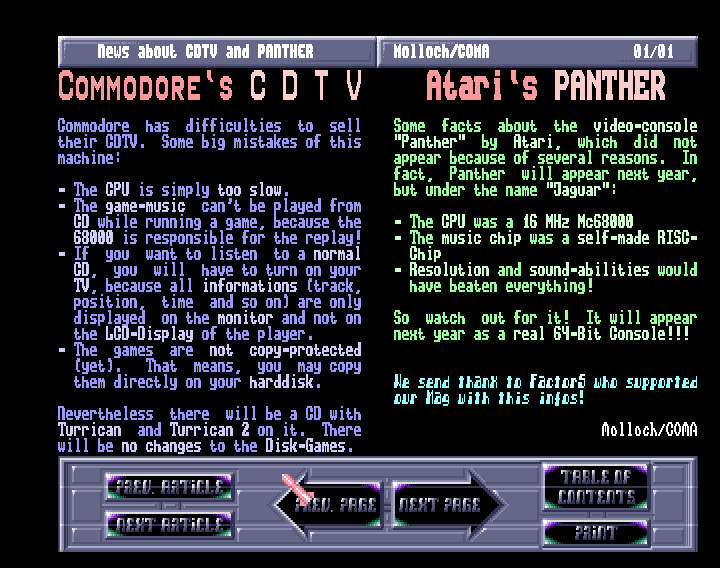
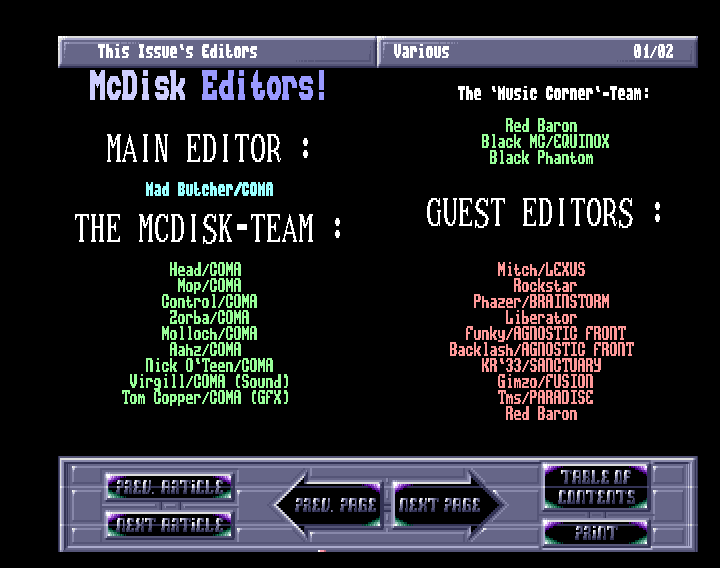
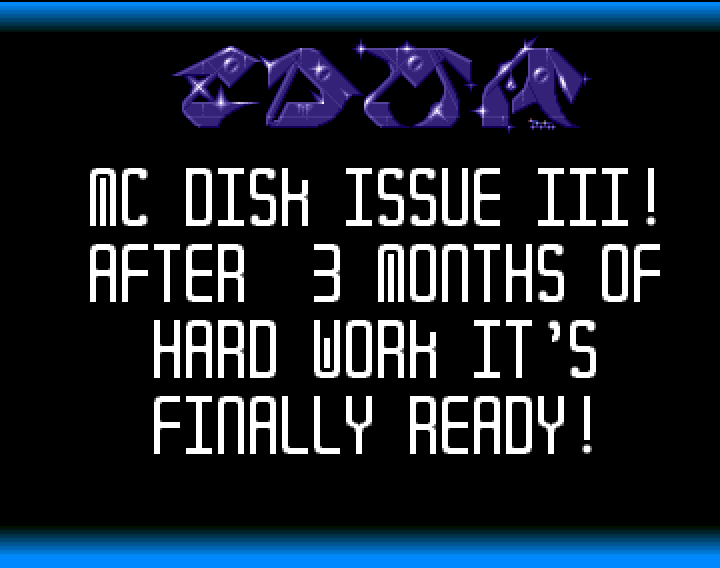
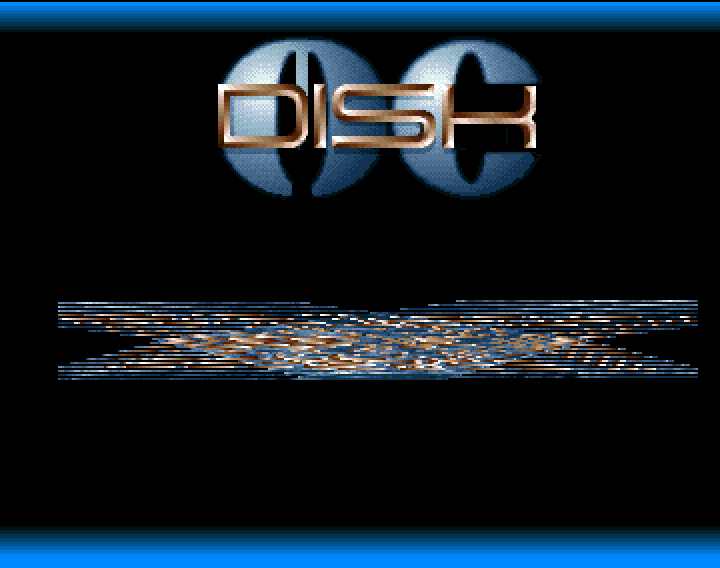
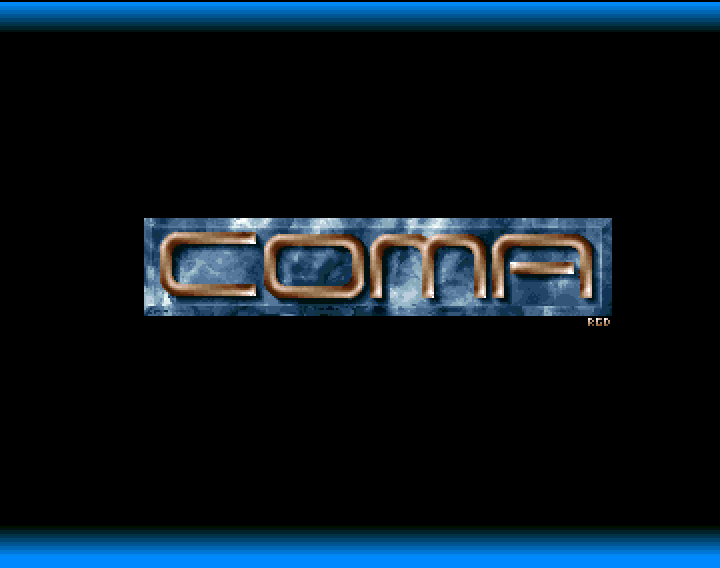

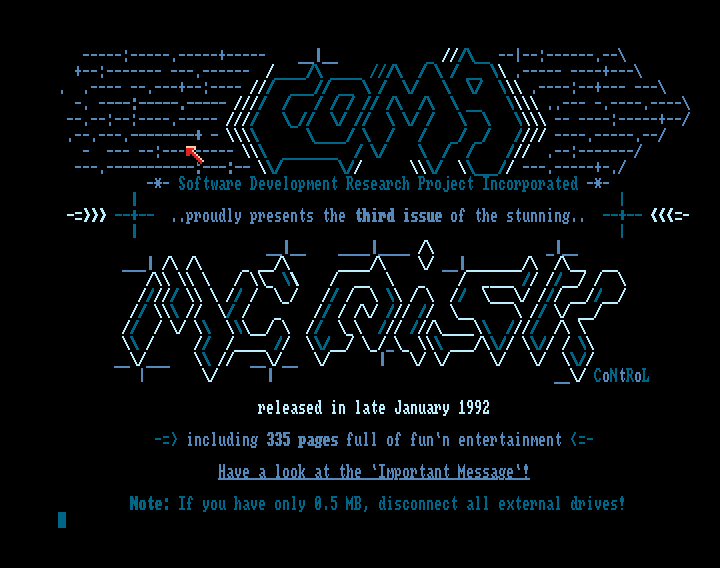
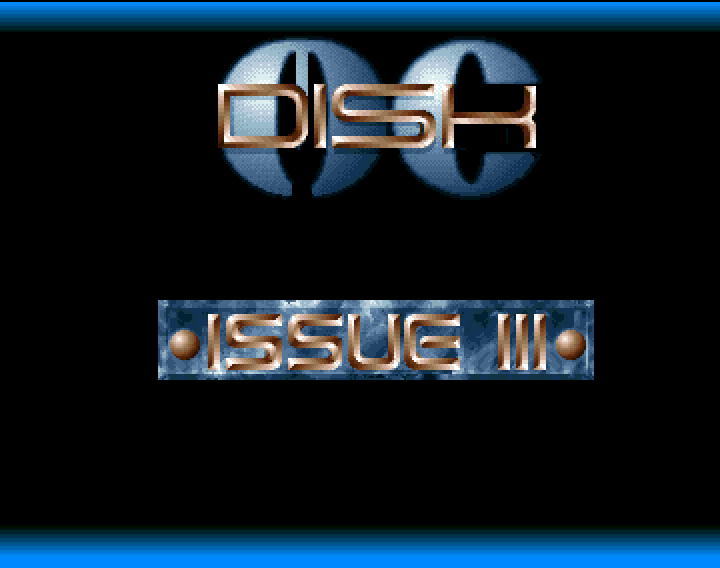
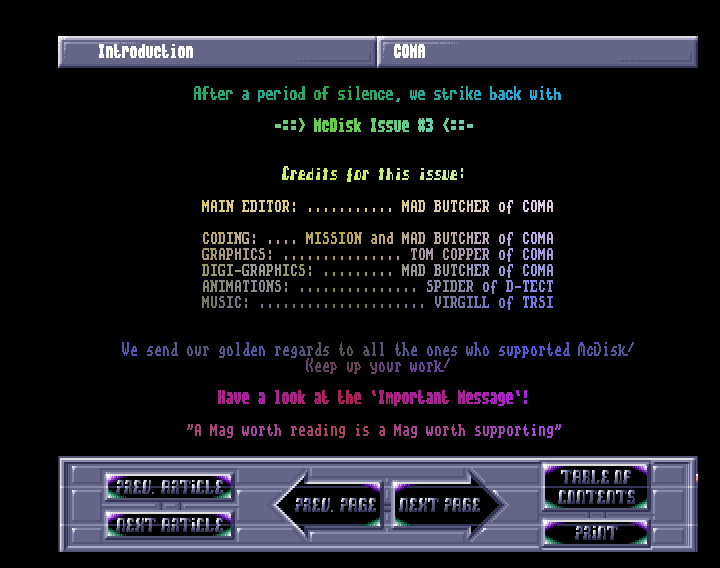
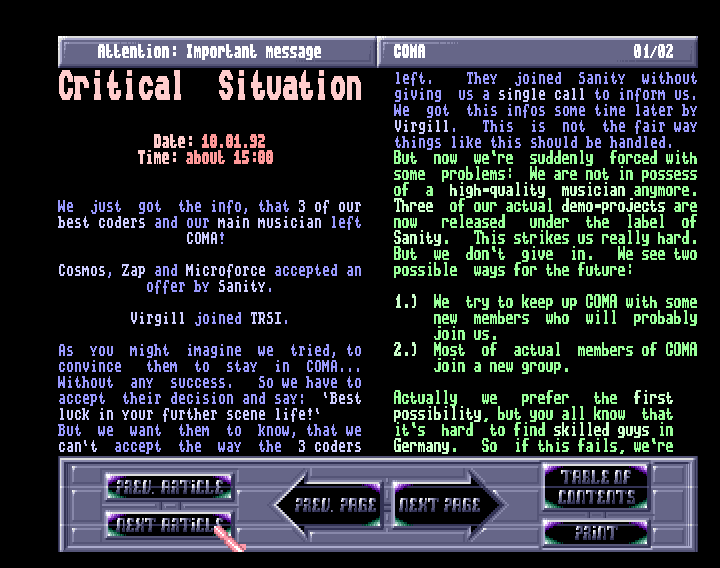

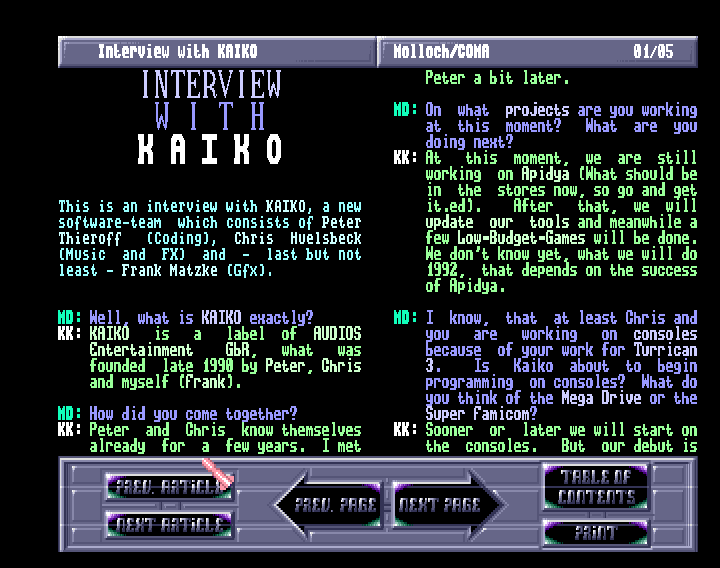
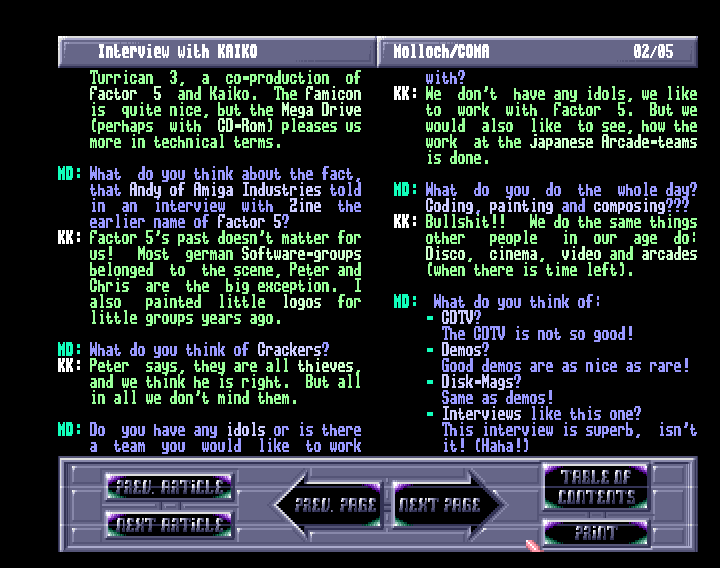
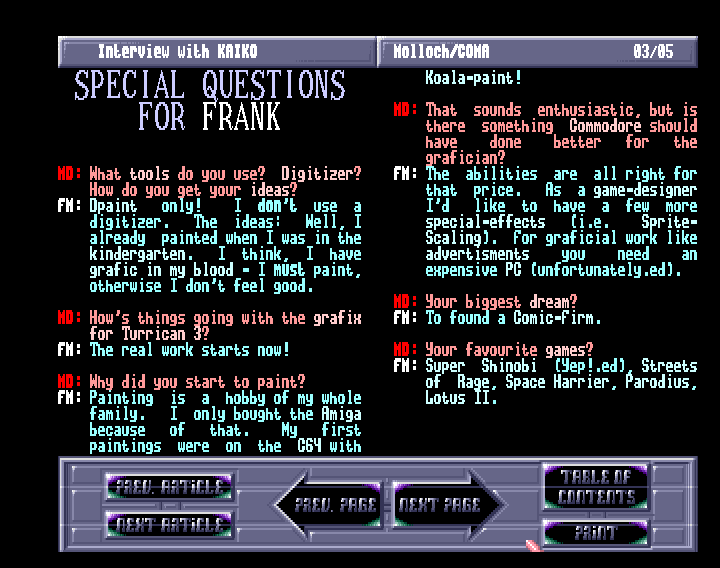
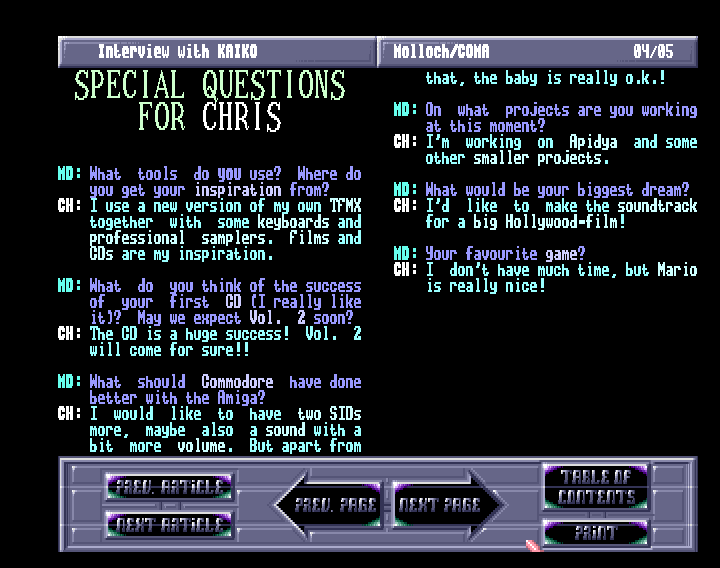

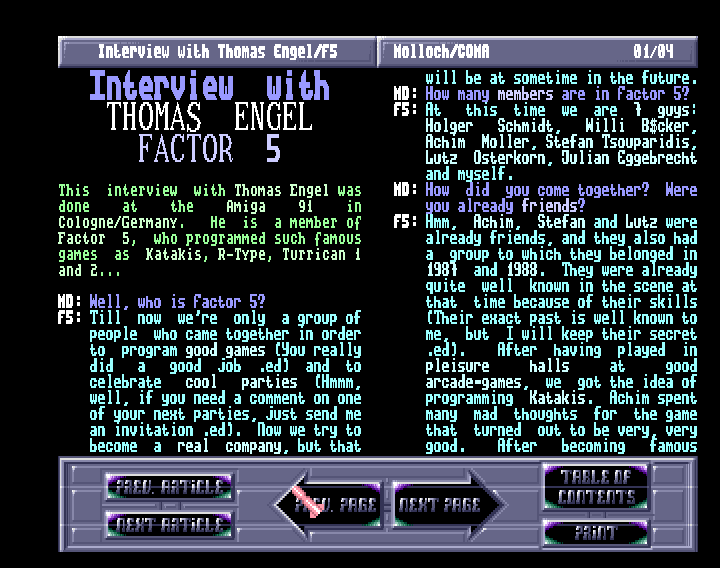
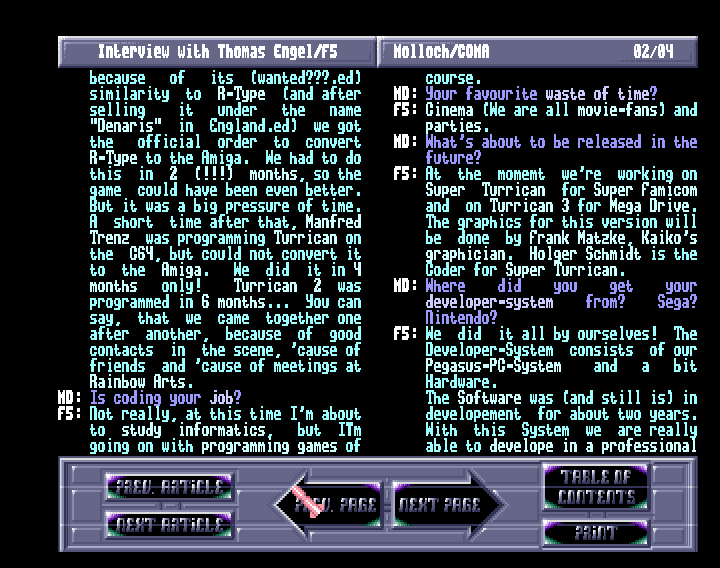
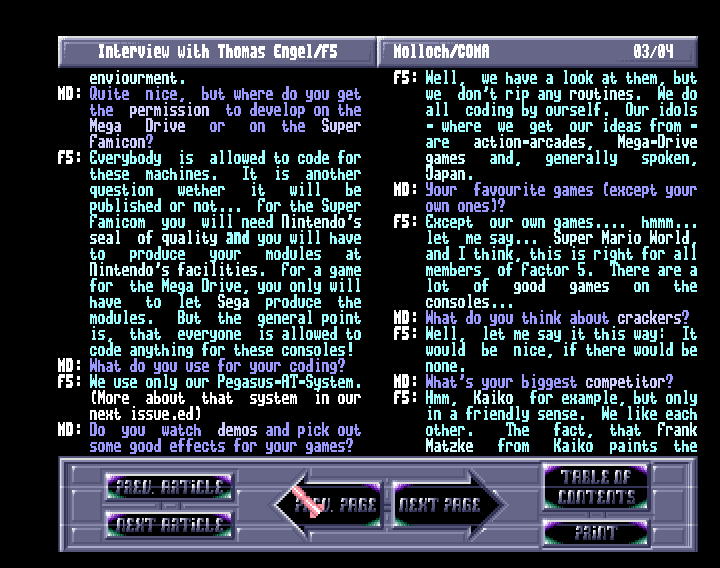
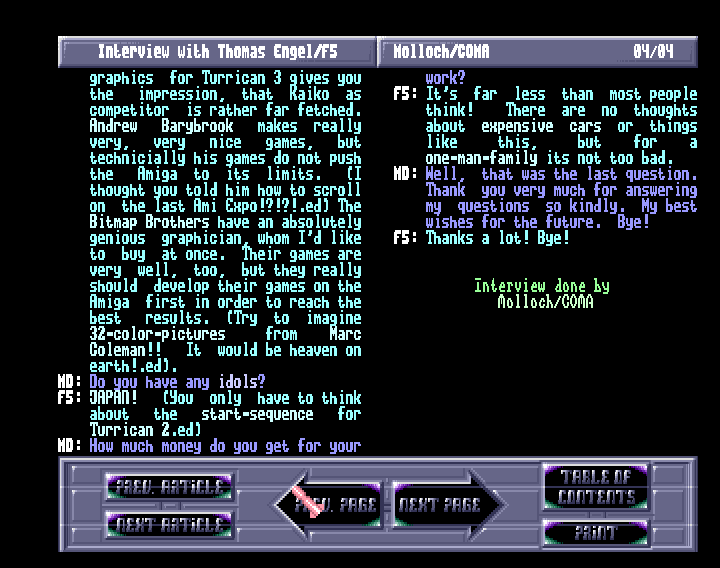

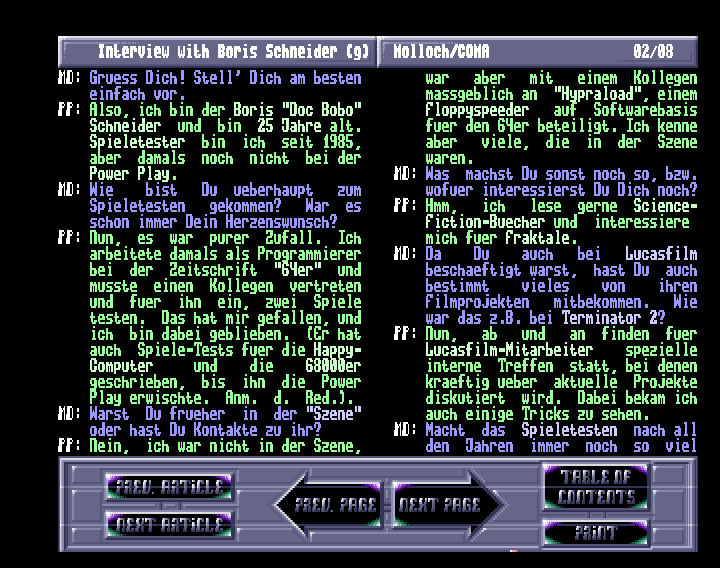
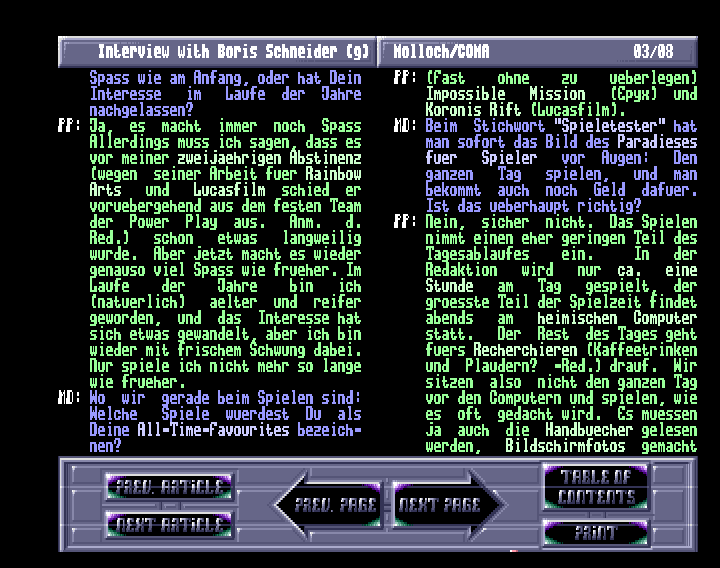
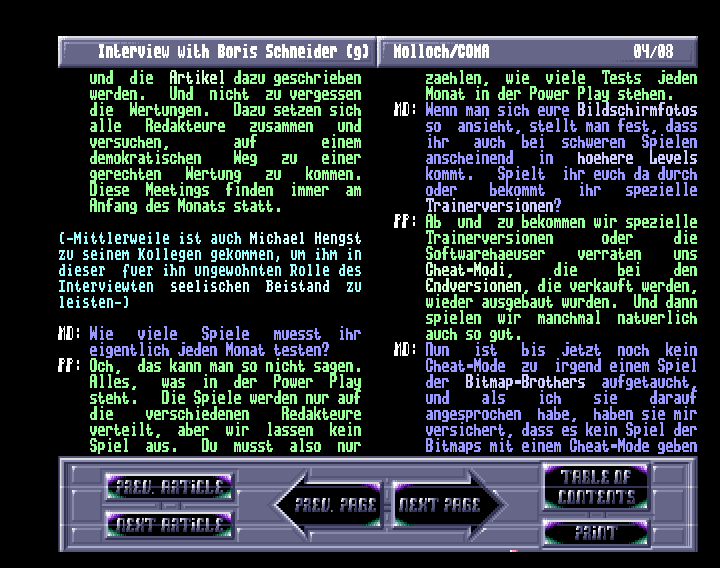

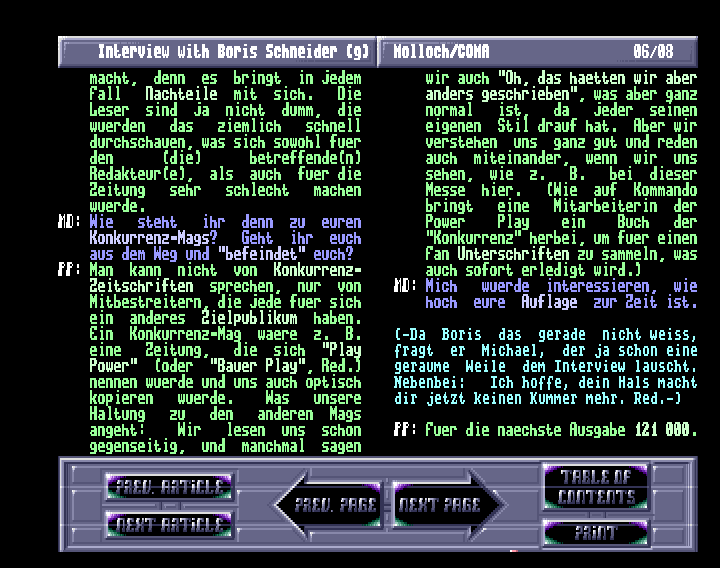
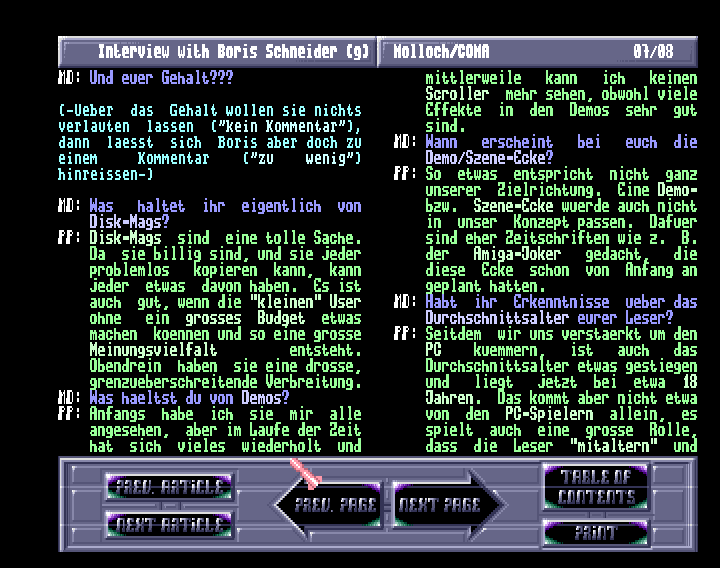
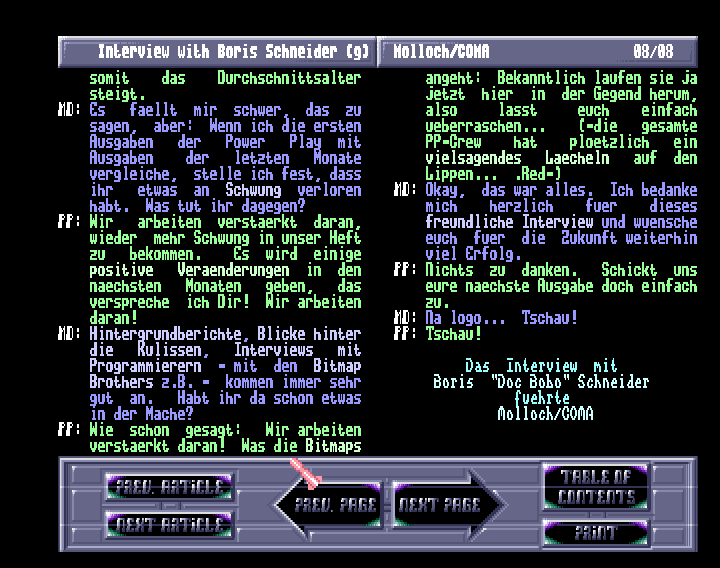
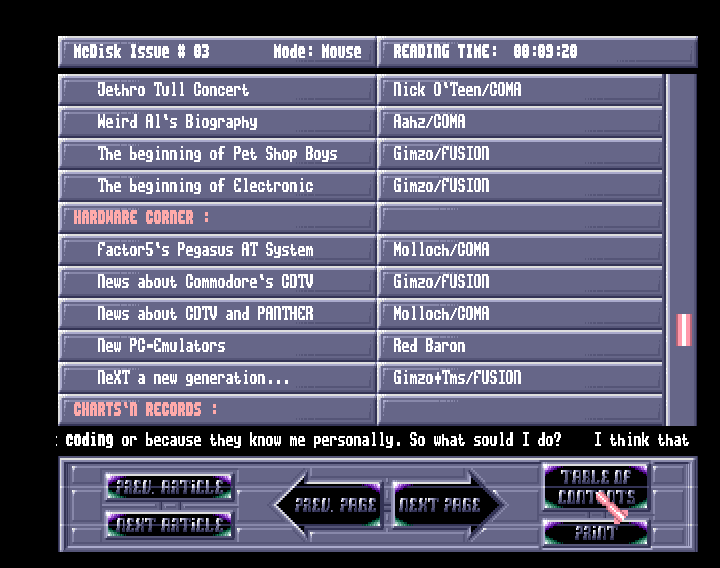
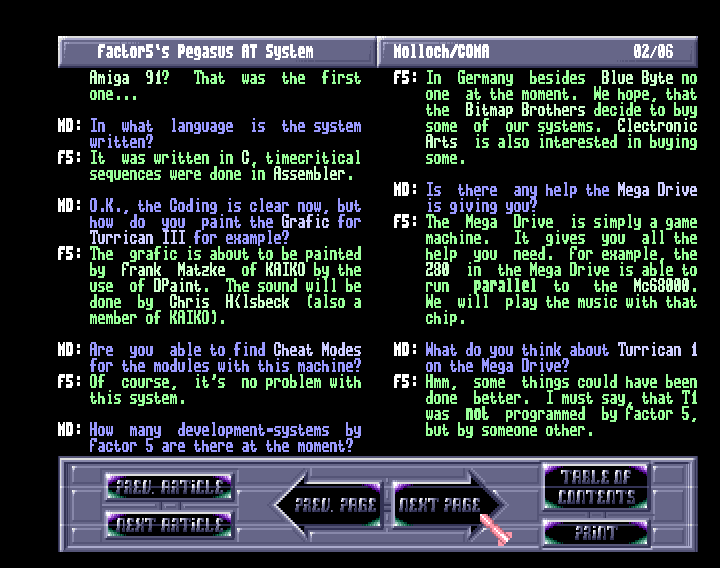
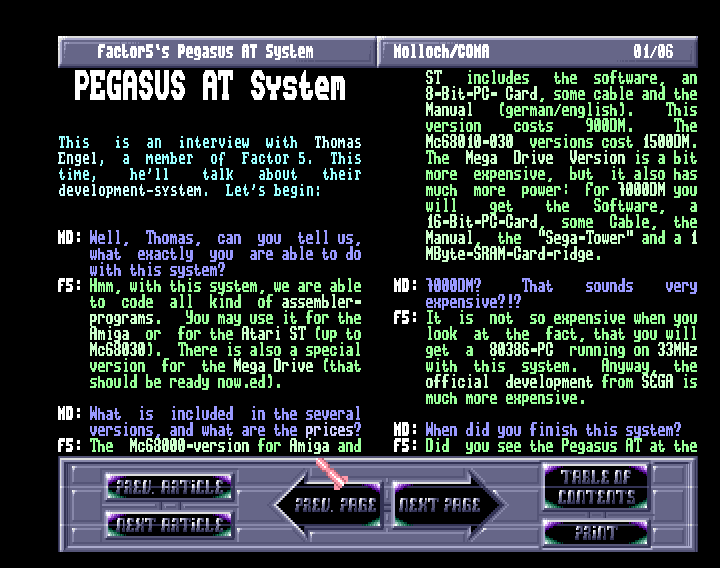
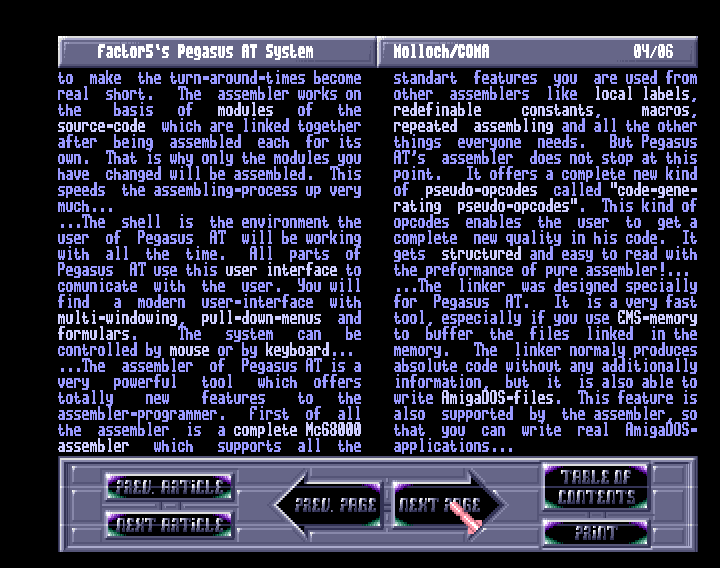


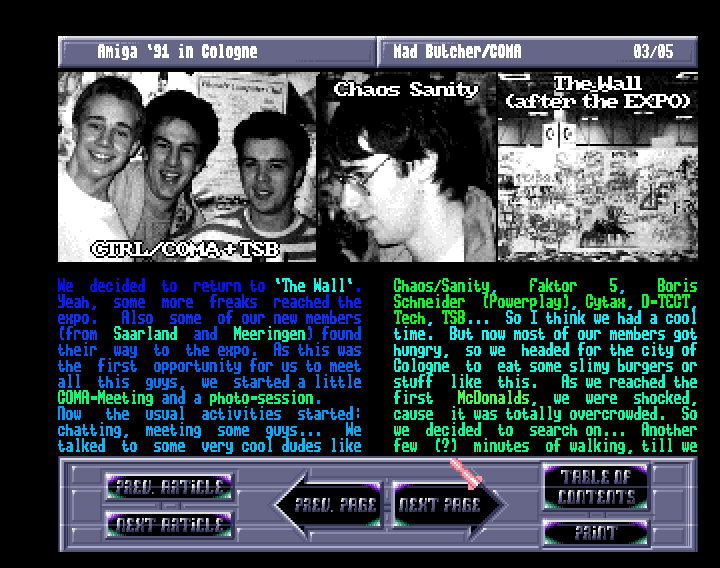
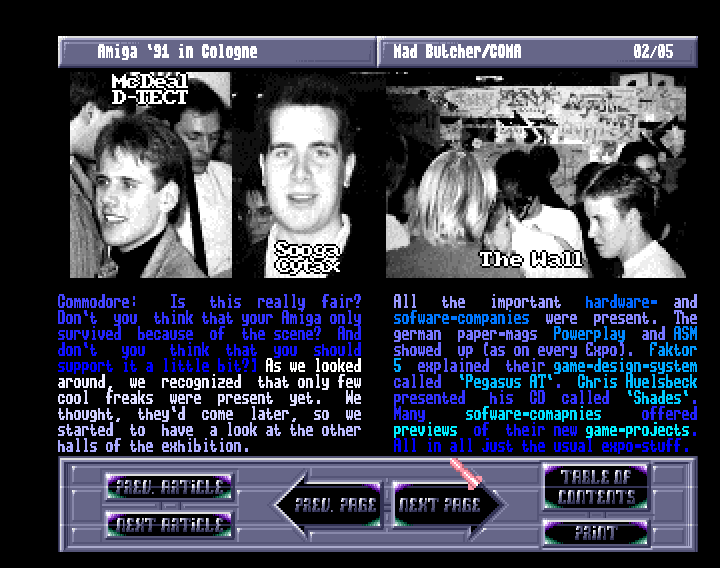
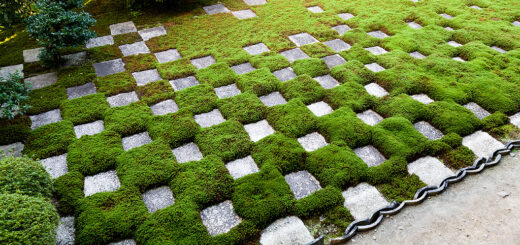
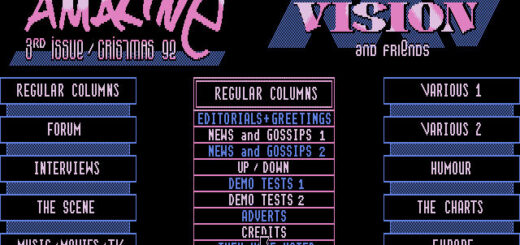











2 Antworten
[…] nun schon einige Monate hinter uns, und in der Zwischenzeit passierte jede Menge: Wechsel zu Coma, viele Interviews auf der Amiga ’91 für McDisk, erste Ideen für ein Spiel… und im Frühjahr 1992 war es klar, dass wir unser Spiel unter […]
[…] produziert werden, und daher wurde es auch nicht unter dem Label „Visdom“ bzw. „Coma“ entwickelt. Wir nannten uns für dieses Spiel „Cybernetic Arts“ und starteten mit […]